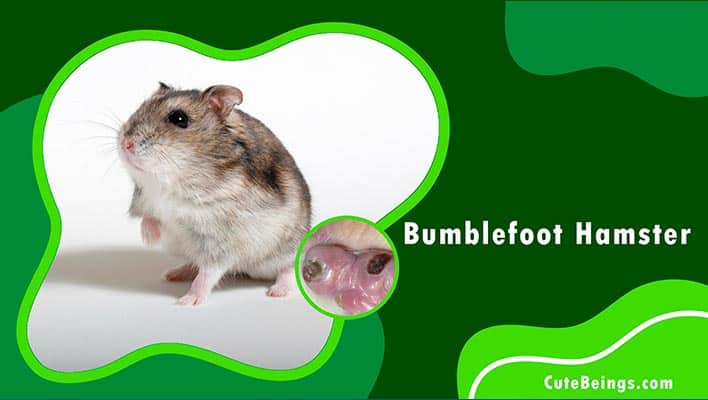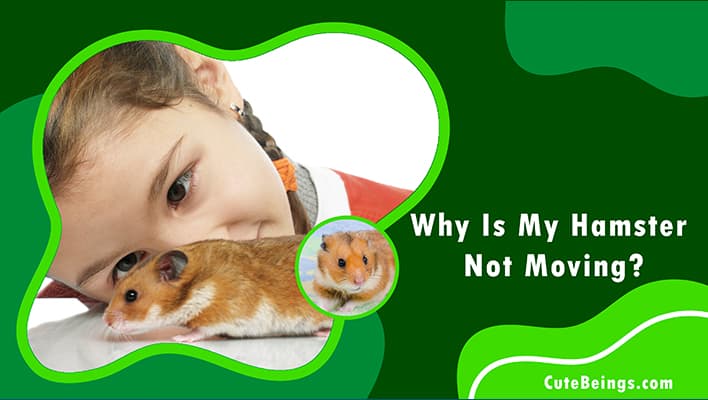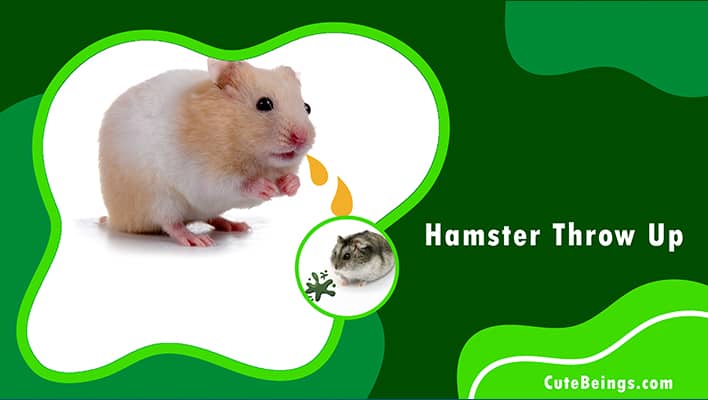Do you know about hamster feet swollen disease in hamsters and other rodents? If you own a hamster you should be aware of it. Because this condition causes severe pain to your lovely pets. So in this article, I am going to describe hamster feet swollen (bumblefoot hamster) disease, how to treat and how to prevent it. Let’s dig in.
Bumblefoot is a physical condition that affects rodents and it is scientifically known as Pododermatitis. You can spot this commonly among rats, guinea pigs and hamsters as well. Pododermatitis is an inflammation of the foot. Literally, the footpad would become inflamed and form sores or bumbles due to this condition. They would usually come up as small red bumps or swells. However, they may tend to enlarge as they mature.
This is not a sudden appearance; there are various environmental factors that could contribute to this condition. If I further describe this, this condition would take place once the hamster’s feet become inflicted with small cuts and scrapes. Once there are cuts and scrapes on the hamster’s feet, bacteria and other microorganisms enter the hamster’s body via those entry points and end up landing at their footpads.
Ultimately it would cause inflammation and infections as well. If you happen to ignore them, chances are that they may progress further and become painful. Keep in mind that, this condition is not infectious to humans. So you don’t have to worry about that.
Table of Contents
What causes bumblefoot in hamsters?
Hamsters may experience this condition due to several factors. For example, poor husbandry practices could be one reason. If you use a meshed surface or a meshed wheel for the hamsters it would lead to this condition.
As such you need to always go for an appropriate wheel for your hamsters.
Other than the wheel if the hamsters are living with poor sanitation it would create bad bacteria in the hamsters. Ultimately they may have a greater potential of having this condition. Apart from that, if your hamsters are having overgrown toenails it would also make them suffer from the bumblefoot. Not only that but also, obesity could be another factor that would result in this.
Pressure sores could also create bumblefoot in hamsters. As aforesaid, any scratches, or scraps of the skin may also pave the way for bumblefoot in hamsters. Furthermore, friction and prolonged exposure to moisture would also cause this condition. In other words, if the hamsters are having moisture on the soft tissue of the bottom of their feet it would also make them prone to this condition. In addition to the aforesaid factors, hamsters’ feces, and urine may also cause the hamsters to have bumblefoot.
How to treat bumblefoot hamster
If the veterinarian decides that your hamster is suffering from bumblefoot, he will start the treatments by giving both oral and injectable medicine. Those medicines would be antibiotics. First and foremost, they will commence the treatments by cleaning the footpads. Next they may trim the toenails . Thereafter they will clip the affected areas so that it will be convenient for them to conduct the treatments.
As the next step, the veterinarian will clean the wounds by soaking their feet in an antibiotic solution. As a general practice, they will apply an antibiotic solution to the affected areas. For better results they will prescribe oral antibiotic medication and let you administer them once you bring them home. Hamsters bumblefoot treatments would vary depending on each case. If by any chance the affected hamsters do not respond to the treatments and the condition is severe it is very likely that the veterinarian would amputate the hamster’ leg.
So in simple terms, the veterinarian would prescribe proper medicine and care for the affected hamsters. Apart from that the doctor would continue to treat the wounds by using daily warm soaks of saline in addition to using antibiotic solutions. They may also prescribe pain control medications as well. If the infection is deep, chances are that the veterinarian would use soft padded bandages so that it would help the hamsters to develop healthy skin. Further if the wound is so severe it would be best to change the bandage on a daily basis.
If the root cause for this condition is obesity, you may need to control the diet until the skin tissues heal. If the disease’s tissues need to be removed, chances are that the hamsters may have to go through surgical operations. Many veterinarians tend to use pain medications such as butorphanol, meloxicam carprofen for surgical treatments. However these could vary depending on the severity of the infection of the hamsters.
Risk factors
Some of the risk factors which would make the hamsters suffer from these conditions are obesity, cages with wire floors, poor sanitation, overgrown toenails etc. These risk factors would make the hamsters more prone towards this condition.
Obesity
If you happen to overfeed the hamsters, they would tend to become overweight. Once the hamsters suffer from excess weight, it would put immense pressure on their feet. Eventually it would result in irritations and pains in the footpads.
Cages with wire floors
If you have placed the hamsters in cages that have wire floors, chances are that they may cause injuries to the hamsters. If by any chance the hamsters are already obese and if they happen to have wire flooring chances are that they may end up having intensified pain and severe irritation in the feet pads of the hamsters.
Poor sanitation
If you don’t change the bedding on a frequent basis it would result in urine, and feces build-ups. Additionally, it may also result in excess moisture build-ups as well. Those conditions are ideal for the bacteria to grow and multiply. Hence, they can enter the hamster’s footpads easily when there is a wound.
Overgrown toenails
Overgrown toenails could be another risk factor that would result in this condition. If the hamster’s nails are not cut on a regular basis and if they have overgrown chances are that they may result in an imbalance in hamster feet. It would create a specific pressure that would result in the pododermatitis. Chances are that the extremely long nails can even curl to the point where they can even puncture the feet pads resulting in pain and discomfort to them.
Bumblefoot hamster symptoms
Detecting the pododermatitis condition among the hamsters is quite easy as they may tend to show multiple symptoms once they suffer from this condition. For example, they may tend to develop swollen feet or red feet. In addition to that, you could spot lames and refuse to move around the cage as well.
Apart from that, they may tend to become more lethargic than they used to be before. Furthermore they may tend to be extremely sensitive and develop sore hind feet too. If the infection is severe you could see them carrying ulcerations on their feet too. Furthermore, they may tend to lose the appetite in eating and tend to be depressed as well. They would lose weight and tend to hide as well.
Complications
Bumblefoot is not a complex condition to deal with given that you diagnose it well in advance. As such you need to ideally check for the hamster’s feet to see if they have developed any early signs of this condition. If you keep the complications to progress further without treating them chances are that they may tend to become worse.
For example, they may start to suffer from much more severe complications such as swollen lymph nodes, arthritis, inflammation of tendons etc. Lastly, it would also result in protein b ( Amyloid) build-up in critical organs such as in the kidney, spleen, liver hormone glands and in pancreas as well.
Prevention methods
There are some preventive measures that you could practice to prevent this condition from occurring. Once you practice these preventive measures it would help to keep the pets healthy and happier.
First, provide proper housing
Ensure that you provide a cage with a smooth floor. Then it would avoid any excess pressure and discomfort which may take place due to a cage with wire floors. Besides, consider providing a soft bedding material such as shredded paper, and soft grass as it would make the bedding comfier for them. Ensure the chosen bedding is absorbent, nontoxic and dust free as well. Do not use cedar chips and fresh pine materials as those could be toxic for some hamsters. Ensure that you remove the urine and feces from the cages on a constant basis as then it would avoid any potential build up of bacteria.
Prevent obesity
Once you keep the hamsters at a healthy weight it would allow the hamsters to grow healthily and happily. So try to provide the hamsters with a complete and a balanced diet. If you have doubts on feeding the hamsters, consult the veterinarian and get their advice.
Trim toenails frequently.
I encourage you to trim the hamsters’ toenails on a frequent basis. Besides , it would avoid having any wounds due to the overgrown nails which would be a risk factor for this condition. If you are unsure and worried on how to trim the hamster’s nails, you may consult the vet doctor and get their input.
What do I do if my hamster has a bumblefoot?
You should immediately contact your veterinarian. Since this is a bacterial related disease you should not use the over the counter medicine for your pet. They need immediate attention otherwise there will be severe repercussions. Therefore as mentioned before immediately;y contact your veterinarian if you observe any signs of bumblefoot disease.
It is very simple to diagnose the bumblefoot condition. Your veterinarian would first examine the pet’s foot. Thereafter they would listen to the hamster’s heart, lungs palpate and on the entire body. Thereafter they will conduct a proper check up on the eyes, ears as well. In addition to that they may also conduct some lab tests to identify the exact bacteria which has affected them. Once they determine the specific bacteria , they will prescribe the right medication for the hamsters.
Can bumblefoot resolve itself?
Bumblefoot cannot resolve itself. Unfortunately, they will not go back to what they were before naturally. Once you use the right medications only they will resolve. If you keep them unattended chances are that they may become severe.
Can bumblefoot kill a hamster?
If you don’t treat the bumblefoot in hamsters chances are that it would time out to be fatal to the hamsters. In other words, it could even kill the hamster if you just let it progress.
Conclusion
To wind up, bumblefoot could arise at mild, easily treatable or severe levels. However, if you practice the right steps you could treat this condition much more effectively. That said if you follow the aforesaid preventive measure that would also help the hamsters to be secure from this condition and to stay healthy. If the hamsters tend to develop this condition on a constant basis, you need to determine the exact root cause and then prevent it.

Hello, my name is James and I’ve been caring for tiny pets for over 14 years with a passion. I enjoy passing on my expertise to other individuals in order for them to have the same amount of enjoyment as I do.




